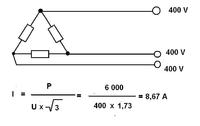Hello :)
I am asking for urgent help and advice from everyone who knows the subject :)
I need to connect (I have sufficient power allocation):
1.5 storage furnaces, each 6kWh / 400V
2. 3 storage heaters, each 6kWh / 400V
I would like to ask for advice, what cables and security should I use to connect the stoves ???
I would like to ask for the cable cross-section, but also for the name (symbol) of the cable. following the example of cables available in Castorama. And here I especially mean that a cable with thick insulation is terribly expensive compared to the same cable in thinner insulation, so I would not like to overpay and ask someone of you who knows about it, to calculate it in such a way that it was very exaggerated, just so that it would be calm enough.
I give (for convenience) which cables are available in Catrorama:
YDYpżo 450/750
YDYżo 450/750
YKYżo 0.6 / 1 kV
OWY (H05W-F) 300 / 500V
OWY (H05W-F) 300 / 500V
OPDżo (H07RN-F) 450 / 750V
Thanks in advance for any help :)
Kind regards
Gregory
I am asking for urgent help and advice from everyone who knows the subject :)
I need to connect (I have sufficient power allocation):
1.5 storage furnaces, each 6kWh / 400V
2. 3 storage heaters, each 6kWh / 400V
I would like to ask for advice, what cables and security should I use to connect the stoves ???
I would like to ask for the cable cross-section, but also for the name (symbol) of the cable. following the example of cables available in Castorama. And here I especially mean that a cable with thick insulation is terribly expensive compared to the same cable in thinner insulation, so I would not like to overpay and ask someone of you who knows about it, to calculate it in such a way that it was very exaggerated, just so that it would be calm enough.
I give (for convenience) which cables are available in Catrorama:
YDYpżo 450/750
YDYżo 450/750
YKYżo 0.6 / 1 kV
OWY (H05W-F) 300 / 500V
OWY (H05W-F) 300 / 500V
OPDżo (H07RN-F) 450 / 750V
Thanks in advance for any help :)
Kind regards
Gregory



